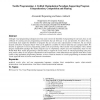Free Online Productivity Tools
i2Speak
i2Symbol
i2OCR
iTex2Img
iWeb2Print
iWeb2Shot
i2Type
iPdf2Split
iPdf2Merge
i2Bopomofo
i2Arabic
i2Style
i2Image
i2PDF
iLatex2Rtf
Sci2ools
128
click to vote
VL
1996
IEEE
1996
IEEE
Tactile Programming: A Unified Manipulation Paradigm Supporting Program Comprehension, Composition and Sharing
Although visual programming techniques have been used to lower the threshold of programming for end users, they are not sufficient for creating end user programming environments that are both easy to use and powerful. To achieve this, an environment must support the definition of programs that are not just static representations of behavior, but are instead dynamic collections of program objects which can be applied in a number of contexts rather than just a program editor. We describe an approach to end user programming called tactile programming which extends visual techniques with a unified program manipulation paradigm that makes programs easy to comprehend, compose and, most importantly, share over the World Wide Web. Tactile programming's inherent ability to support the social context in which programming takes place along with its ability to ease program comprehension and composition is what differentiates this approach from others. In the context of the Agentsheets progra...
| Added | 07 Aug 2010 |
| Updated | 07 Aug 2010 |
| Type | Conference |
| Year | 1996 |
| Where | VL |
| Authors | Alexander Repenning, James Ambach |
Comments (0)

